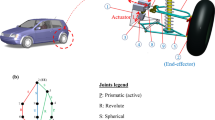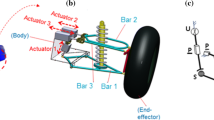Abstract
In this paper, we introduce the concept of working volume of an automotive suspension system as a measure of the space occupied by it, and exemplify its use in design criteria for more compact suspension systems. This can aid in satisfying the increasing constraints imposed by electric vehicles, which need more space for batteries and in-wheel motors, while also accounting for kinematical performance measures. The design criteria are first illustrated in a planar model via the concept of projected working area, and then used in a spatial model as the working volume. A large amplitude model of a SLA double wishbone suspension is used which includes geometrical nonlinear terms. The design criteria are first illustrated in a planar model via the concept of projected working area, and then used in a spatial model as the working volume. Planar and spatial analyses show that a simpler model can give valuable insight into the camber and track behaviour of the suspension system, while also serving as good predictor of the working volume of the spatial model. With the procedure presented in the manuscript, a designer is able to directly relate a reduction in area with resulting camber gain and track variation, or any other kinematic metric of choice, which can greatly simplify the process of a preliminary design. Although the criteria are defined based on a double wishbone geometry, they can be used in other geometries.












Similar content being viewed by others
References
Attia HA (2002) Dynamic modelling of the double wishbone motor-vehicle suspension system. Eur J Mech A/Solids 21:167–174. https://doi.org/10.1016/S0997-7538(01)01178-0
Balike KP, Rakheja S, Stiharu I (2011) Development of kineto-dynamic quarter-car model for synthesis of a double wishbone suspension. Veh Syst Dyn 49:107–128. https://doi.org/10.1080/00423110903401905
Barber CB, Dobkin DP, Huhdanpaa HT (1996) The quickhull algorithm for convex hulls. ACM Trans Math Softw 22:469–483
Dixon JC (2009) Suspension geometry and computation. Wiley, New York
Fallah MS, Mahzoon M, Eghtesad M (2008) Kinematical and dynamical analysis of MacPherson suspension using displacement matrix method. Iranian J Sci Technol Trans B Eng 32:325–339
Fernandes JCM, Gonçalves PJP, Silveira M (2020) Interaction between asymmetrical damping and geometrical nonlinearity in vehicle suspension systems improves comfort. Nonlinear Dyn 99:1561–1576
Fernandes JCM Silveira M (2018) Optimising geometry and asymmetrical damping ratio to reduce vehicle vertical acceleration under stochastic road profile. In: ISMA 2018, pp 1–11
Fernandes JCM, Silveira M, Pontes Junior BR, Balthazar JM (2015) Effects of asymmetrical damping ratio and damper inclination on vertical dynamics of a suspension system. Math Eng Sci Aerosp (MESA) 6:391–398
Fuhs A (2009) Hybrid vehicles and the future of personal transportation. CRC Press, Boca Raton
Kwietniewski M, Bil T (2020) Analysis of the non-wishbone mechanism in a vehicle wheel suspension. J Theor Appl Mech 58:109–115. https://doi.org/10.15632/jtam-pl/115319
Liu M, Gu F, Huang J, Wang C, Cao M (2017) Integration design and optimization control of a dynamic vibration absorber for electric wheels with in-wheel motor. Energies 10:2069. https://doi.org/10.3390/en10122069
Mántaras DA, Luque P, Vera C (2004) Development and validation of a three-dimensional kinematic model for the McPherson steering and suspension mechanisms. Mech Mach Theory 39:603–619. https://doi.org/10.1016/j.mechmachtheory.2003.12.006
Niu Z, Jin S, Wang R, Zhang Y (2021) Geometry optimization of a planar double wishbone suspension based on whole-range nonlinear dynamic model. J Automob Eng. https://doi.org/10.1177/09544070211026205
Norton RL (2004) Design of machinery. McGraw-Hill, New York
Papegay Y, Merlet JP, Daney D (2005) Exact kinematics analysis of car’s suspension mechanisms using symbolic computation and interval analysis. Mech Mach Theory 40:395–413. https://doi.org/10.1016/j.mechmachtheory.2003.07.003
Reddy KV, Kodati M, Chatra K, Bandyopadhyay S (2016) A comprehensive kinematic analysis of the double wishbone and MacPherson strut suspension systems. Mech Mach Theory 105:441–470. https://doi.org/10.1016/j.mechmachtheory.2016.06.001
Rill G, Castro AA (2020) Road vehicle dynamics, 2nd edn. CRC Press, Boca Raton
Sancibrian R, Garcia P, Viadero F, Fernandez A, De-Juan A (2010) Kinematic design of double-wishbone suspension systems using a multiobjective optimisation approach. Veh Syst Dyn 48:793–813. https://doi.org/10.1080/00423110903156574
Simionescu PA (2016) A unified approach to the kinematic synthesis of five-link, four-link, and double-wishbone suspension mechanisms with rack-and-pinion steering control. Proc Inst Mech Eng Part D J Automob Eng. https://doi.org/10.1177/0954407016672775
Tanik E, Parlaktas V (2015) On the analysis of double wishbone suspension. J Adv Mech Des Syst Manuf 9:15–00297. https://doi.org/10.1299/jamdsm.2015jamdsm0037
Uchida T, McPhee J (2012) Driving simulator with double-wishbone suspension using efficient block-triangularized kinematic equations. Multibody Syst Dyn. https://doi.org/10.1007/s11044-011-9299-y
Wang R, Jing H, Yan F, Karimi HR, Chen N (2015) Optimization and finite-frequency H\(_{\infty }\) control of active suspensions in in-wheel motor driven electric ground vehicles. J Frank Inst 352:468–484
Author information
Authors and Affiliations
Corresponding author
Ethics declarations
Conflict of interest
The authors declare that they have no conflict of interest.
Additional information
Publisher's Note
Springer Nature remains neutral with regard to jurisdictional claims in published maps and institutional affiliations.
Rights and permissions
About this article
Cite this article
Silveira, M., Fernandes, J.C.M. Incorporating working volume and projected area in design criteria for automotive SLA suspension. Meccanica 57, 2173–2185 (2022). https://doi.org/10.1007/s11012-022-01558-w
Received:
Accepted:
Published:
Issue Date:
DOI: https://doi.org/10.1007/s11012-022-01558-w




